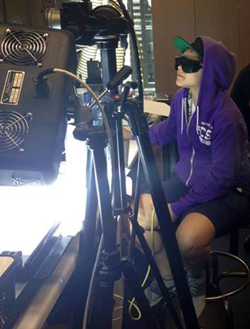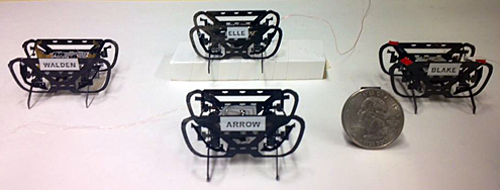Bio-inspired Robotics Engineering: Taking a Cue from Insects
What can engineers learn from studying the ways in which bugs and insects move? A great deal! Robotics labs like the Harvard Microrobotics Lab are using bio-inspired research and observation to design and test new approaches to designing and building small robots. Meet a female engineer working in the lab. She may not be keen on bees, but when it comes to coin-sized bots, she is excited by the challenge of taking what insects already do well and creating better, faster, and more efficient microrobots.

Flying Smart with Butterfly Wings
Dani's lab is using bio-inspired research to further robotics design and engineering, but other fields, too, study bio-systems to help improve existing systems, technologies, and understanding.
In the "Butterfly Wings: Using Nature to Learn About Flight" aerodynamics project, students make model butterflies to explore how changes in the angle of a butterfly's wing, relative to the wind, changes the lift force of the wing. Insect-inspired research may inform robotics design, but as this project shows, this research can also help address science questions and improve designs in other areas!
Kids who grow up building and tinkering grow up loosely using and enacting principles of the engineering design process. While these systems play a key role in facilitating childhood creativity and innovation, many kids outgrow their interest, snap-together building blocks and circuit kits being replaced by other activities and hobbies. For girls, the drop-off rate in interest in engineering toys may be even more dramatic.
Luckily, there are female engineers like Dani whose interest never wanes. She started out building, and she hasn't stopped yet.
Supporting Student Engineers
Thanks to support from her family, Dani's childhood passion was nurtured and encouraged. Today, she is applying, exploring, and expanding her interest as part of her undergraduate studies at Harvard where she works in the Harvard Microrobotics Lab, an electronics and robotics lab that specializes in research related to microrobots inspired by real-world bugs and insects.
"Growing up, support from family, friends, and teachers really helped me get more involved and excited about engineering and math and science in general," says Dani. "I had always been interested in building things, and my family encouraged me to do so despite the fact that they had no engineering or technical knowledge. They would buy kits for me where I would get to build model engines or play with magnets and circuits, and my uncle would hang out with me on weekends and teach me how to use power tools." In addition to lots of great engineering projects and kits at home, Dani participated in summer programs that let her continue to explore engineering and robotics.
At school, Dani says her teachers helped encourage and feed her interests by giving her extra challenges to work on, by helping as mentors in the after-school robotics program, and by making her aware of opportunities like the BAE System's Women in Technology Program. Dani was fortunate to have strong support, support that extended beyond the boundaries of in-class curriculum. "These opportunities helped compensate for what I saw as a lack of hands-on [science and engineering] activities in classes at school," she recalls. "We had lab periods in school and did several projects, but not nearly the amount I would have hoped for. I think it was really important for me to work on projects out of class to help me learn."
Making Room for Girls in Robotics
Programs and clubs like FIRST® robotics are often integral for students like Dani and help support the engineering spirit during middle and high school years. Dani recalls doing summer programs devoted to LEGO® Mindstorms, but she cites her participation in FIRST robotics as a powerful force in her development as a young engineer. As a young woman, however, her four years in robotics club also highlighted the disproportionate number of girls pursuing engineering by the time high school rolls around.
"There were very few girls on the robotics team I participated on in high school," admits Dani. "Over my four years on the team, only a handful of us actually participated in designing and building the robot." Though she categorizes the gender imbalance as discouraging, her team was fortunate to have a female mentor, which gave her and other teammates a role model and source of inspiration. Even so, "I do wish more women were encouraged to be involved in the sciences and join teams like robotics teams," says Dani.
The relationship between gender and engineering that Dani saw play out in robotics club is something she has continued to see in her college studies. "By looking at the demographics of the classes I'm in, the professors I've had, and the make-up of the engineering-related extracurriculars I'm involved in, I do feel like robotics and mechanical engineering are male-dominated fields. Often, I am one of the few women and people of color in these spaces."

Microrobots to the Rescue
The miniature robots being built and tested in the lab may be used in a range of current and future applications. Search and rescue and exploration of environments unsafe for humans are areas Dani notes are particularly relevant to her lab's research.
"Many lives could be saved in the future," says Dani by way of example, "if, instead of sending humans into dangerous places, such as toxic areas or debris-ridden buildings after natural disasters, robotic bugs were sent instead!"
Students can explore robotics with a search-and-rescue mission in the "Robots to the Rescue! Build & Test a Search-and-Rescue Robot" Project Idea. The robot in the project involves a toy radio-controlled car, so it is many times larger than Dani's robots in the Microrobotics Lab, but the Project Idea lets students get started thinking about and testing important issues related to using robots in this way.
"While things are getting better, I think these fields have a long way to come in terms of gender, racial, and class balance and that awareness of this and outreach are important steps to start changing this."
Inspired by Insects
Dani isn't a fan of cockroaches or bees and says she really would not want to work on projects that involve handling or close observation of either. But, in fact, Dani's work at Harvard centers on the design and development of robotic insects, robots inspired by the biology of other creatures. "Our lab models much of our work off of organisms and structures that already exist in nature. Why try to recreate the wheel when you can look at something that works amazingly (which so many things in nature already do) and mimic it to obtain good results," Dani explains. "Plus, it's fun to work with bugs and try to learn from them!"
Taking their cue from nature, Dani explains that research teams in the lab are working on both flapping-wing and ambulatory microrobots—bugs that fly and bugs that crawl. Both approaches to mobilizing a robot have different challenges. "Because both types are on extremely small scales (about the size of a quarter or smaller), mass is a huge issue," says Dani.
"Ambulatory robots need to remain light so that their transmissions are able to provide enough force for the robot's legs to lift the body's mass," explains Dani. "Flapping-wing robots need to remain even lighter so that they are still able to fly. This makes it difficult to put power supplies on board (batteries are heavy!)." Flapping-wing robots also present challenges for navigation and orientation systems, notes Dani. Flying bots have "lots of complicated control and sensor challenges because the robot needs to know its orientation in air so that it can continue flying under control."
Though cockroaches are not her thing, Dani has been working on a current version of the Harvard Ambulatory MicroRobot (HAMR) that models the design of a cockroach and is about the size of a quarter. Having worked on both ambulatory and flapping-wing robotics projects, Dani says she especially enjoys exploring the kinds of design issues and questions raised by ambulatory robots.
"I think I prefer ambulatory robots because I'm not particularly interested in fluid dynamics or control, which is what a lot of the work on flapping robots is. Rather, I like thinking about the dynamics and locomotion of ambulatory robots. For example, how does the leg gait affect how the robot moves, what kind of leg designs will allow the robot to climb walls, will changing leg materials increase speed?"
In addition to tackling challenges related to the physics and engineering of ambulatory microrobots, Dani says size is always an added variable and consideration. "It is hard to put things in the right place at that scale!"
The size may make building these robots a challenge, but it also makes things interesting when it comes to keeping track of them. With robots the size of a coin, it seems inevitable that they might wander or scuttle away, out of sight, or under something, never to be found again. But Dani says it hasn't happened. "Fortunately we have not lost any bots so far! It can be difficult though," she admits. But what do engineers do when things are difficult? They find solutions!
"With the ambulatory robots I'm currently working on, we put up little 'guard-rails' on the table that it walks on for experiments to make sure that it doesn't run off," explains Dani. "We also are pretty careful about keeping track of the robots when we are done using them and putting them in the drawer we keep them in."
To further help them keep track, Dani says the engineers give the robots names. "Currently we have Elle, Manny, and Actin."
Once they have a name, they are less likely to get overlooked during a daily robot roll call!

Supporting Student Interest in Engineering, Robotics, and Computer Science
February 16-24, 2014 is Engineers Week, and February 20 is Girl Day (formerly "Introduce a Girl to Engineering Day").
Help excite your students—male and female—about engineering and introduce them to what engineering means and what engineers do. Students like Dani are quick to credit the support of teachers, family, and programs that help enable student exploration. The following resources contain ideas, projects, and links that can help kickstart student interest and
- Exciting Girls about Science and Engineering
- Inspiring Future Female Engineers: GoldieBlox Goes to the Super Bowl
- Understanding the Engineering Design Process: Teachers Embracing Engineering Design
- Encouraging and Inspiring Female Student Engineers
- Super Scratch Succeeds in Scratching the Surface of Code with Cartoon Fun
- Playful Programming and Cool Code: From Tech User to Tech Creator
- A Picture Book Look at the Engineering Spirit
- Girls Explore Engineering with Marble Run Challenge
- Girls at After-school Program Science Event Explore Paper Airplanes
Motorola Solutions Foundation, a sponsor of Engineers Week, is a supporting sponsor of Science Buddies.
Categories:
You Might Also Enjoy These Related Posts:
- Plastics and Earth Day - Science Projects
- Arduino Science Projects and Physical Computing
- 10+ Robotics Projects with the BlueBot Kit
- 5 STEM Activities with Marshmallow Peeps
- March Madness Basketball Science Projects: Sports Science Experiments
- Women in STEM! More than 60 Scientists and Engineers for Women's History Month
- Explore Artificial Intelligence and Machine Learning with Student AI Projects
- 10 Reasons to Do the Rubber Band Car Engineering Challenge










